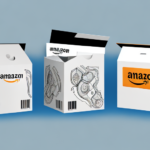Unlocking the Benefits of Fulfillment by Merchant
If you're running an online business, managing your inventory and shipping can feel like a daunting task. That's where Fulfillment by Merchant (FBM) comes in. This article provides an in-depth overview of FBM, explains how it works, and explores the top reasons why it's a great option for small business owners.
Understanding Fulfillment by Merchant (FBM) and How It Works
Fulfillment by Merchant (FBM) refers to the process of fulfilling orders by the seller of the products. This means that you, the merchant, are responsible for storing your inventory, processing orders, and shipping them out to customers. FBM is a popular option for small businesses that want to maintain control over their inventory and shipping processes. By handling fulfillment in-house, you can provide a more personalized customer experience and have greater control over the entire sales process.
To get started with FBM, you'll need to create a shipping plan, which includes the products you'll be shipping, their quantities, and the shipping method you'll be using. Once your inventory is stored in your warehouse, you'll receive orders from your online store, which you'll need to process and ship out. This can be done using a range of shipping carriers depending on your preference.
One of the benefits of using FBM is that you can save money on fulfillment costs. By handling the process in-house, you can avoid paying fees to third-party fulfillment companies. Additionally, you can negotiate better rates with shipping carriers since you'll be shipping a higher volume of packages.
However, it's important to note that FBM requires a significant amount of time and resources. You'll need to have a dedicated team to handle inventory management, order processing, and shipping. If you're a small business owner, you may need to hire additional staff or outsource some of these tasks to ensure that you can fulfill orders in a timely manner.
Top Reasons Why FBM Is a Great Option for Small Business Owners
There are many benefits to using FBM, particularly for small business owners. Here are some of the top reasons why:
- Complete control over your inventory and shipping processes
- Cost savings on shipping by negotiating rates with carriers
- Personalized customer experience
- Customized packaging and branding to increase brand awareness
- Reduced costs associated with third-party fulfillment providers
Another advantage of using FBM is that it allows for faster delivery times. With FBM, you can ship products directly from your own warehouse or storage facility, which can be located closer to your customers. This means that your customers can receive their orders faster, leading to increased customer satisfaction and potentially more repeat business.
According to a 2023 Shopify report, businesses utilizing FBM have seen a 15% increase in customer satisfaction due to faster delivery times and personalized service.
How FBM Can Help You Save Money on Shipping Costs
One of the biggest advantages of FBM is the ability to negotiate lower shipping rates with carriers. Because you're handling shipping in-house, carriers may be more willing to offer you lower rates, particularly if you're shipping a high volume of packages. Additionally, you can choose the shipping method that works best for you and your customers, selecting lower-cost options for those willing to wait longer for their orders.
Another way FBM can help you save money on shipping costs is by allowing you to use your own packaging materials. Third-party fulfillment services often require you to use their packaging, which can be more expensive. With FBM, you can purchase packaging materials in bulk, reducing costs significantly over time.
Finally, FBM enables you to take advantage of regional carriers. These smaller shipping companies specialize in specific regions and often offer lower rates than larger carriers like UPS or FedEx, especially for shorter distances. By using FBM, you can identify where your customers are located and choose a regional carrier that offers the best rates for those areas.
The Benefits of Maintaining Control over Your Inventory with FBM
Maintaining control over your inventory is crucial for small businesses. With FBM, you can keep track of your stock levels, avoid stockouts, and fulfill orders more quickly because you know exactly what you have in stock. Additionally, you can customize your packaging and branding to create a more branded experience for your customers.
Another benefit of maintaining control over your inventory with FBM is the ability to easily manage returns and refunds. Handling these directly allows you to maintain a positive relationship with your customers. Effective inventory management also means you can promptly address customer inquiries, ensuring a high level of customer service.
FBM also gives you more control over shipping costs. By using your own shipping methods, you can negotiate better rates with carriers and save money on shipping. You can even choose to offer free shipping to your customers, a strategy that can attract new customers and increase sales.
How to Get Started with FBM and Tips for Success
Getting started with FBM is relatively easy. Here are a few tips to help you get off to a smooth start:
- Create a shipping plan to ensure you have the right products in stock and are using the appropriate shipping methods
- Use a reliable inventory management system to keep track of your inventory levels and avoid stockouts
- Invest in quality packaging materials to protect your products during shipping
- Establish a clear and concise shipping policy that outlines your process and any shipping deadlines or expectations
Another important tip for success with FBM is to regularly monitor your seller metrics, including your order defect rate, late shipment rate, and cancellation rate. By keeping an eye on these metrics, you can identify areas for improvement and take action to address them.
It's also a good idea to stay up-to-date with industry policies and guidelines for FBM sellers. This includes understanding requirements for product listings, customer communication, and returns and refunds. By following these guidelines, you can avoid potential issues or penalties from platforms like Amazon.
Best Practices for Managing Customer Service with FBM
With FBM, you're responsible for handling all customer service issues related to shipping and fulfillment. To keep your customers happy:
- Have a clear and easy-to-understand return policy
- Provide tracking information as soon as possible
- Respond to customer inquiries in a timely manner
- Be transparent about any delays or issues that may arise with shipping
- Work with your customers to resolve any problems promptly
Additionally, ensure that your products are accurately described and represented on your product listings. This includes providing clear and detailed product descriptions, high-quality images, and accurate information about product dimensions, materials, and features. By providing accurate information upfront, you can help prevent customer dissatisfaction and reduce the likelihood of returns or negative reviews.
How FBM Can Boost Your Brand and Increase Customer Loyalty
FBM allows you to create a more branded experience for your customers. By customizing your packaging and branding, you can increase brand awareness and create a more memorable experience, which can boost customer loyalty and lead to repeat business.
Another benefit of FBM is the greater control over the shipping process. You can choose your own shipping carrier and speed, leading to faster delivery times and more satisfied customers. Additionally, closely tracking the shipping process enables you to provide customers with more accurate shipping information.
FBM also offers flexibility in product offerings. You can sell products that may not be eligible for other fulfillment options, such as oversized or fragile items. This flexibility allows you to expand your product line and offer a wider range of products to your customers. By offering unique products and a personalized experience, you can differentiate yourself from competitors and build a stronger brand identity.
Overcoming Common Challenges with FBM and Maximizing Profits
While there are many benefits to using FBM, there are also common challenges that you may need to overcome, such as managing inventory levels, organizing your warehouse, and dealing with unexpected shipping delays or issues. To maximize your profits with FBM:
- Efficiently manage your inventory and shipping processes
- Regularly check your shipping rates to ensure you're getting the best deals
- Focus on providing a high-quality customer experience
Implementing robust inventory management systems and using data analytics can help you anticipate and prevent stockouts or overstock situations. Additionally, partnering with reliable shipping carriers and having contingency plans for delays can mitigate potential disruptions.
Comparing FBM to Other Fulfillment Options: Which Is Right for You?
There are many fulfillment options available to online businesses, including Fulfilled by Amazon (FBA) and third-party fulfillment providers. When deciding which option to choose, consider your business needs and goals, as well as the specific advantages and disadvantages of each option:
- FBM: Ideal for small businesses wanting to maintain control over their inventory and shipping processes.
- FBA: Suitable for businesses looking to leverage Amazon's vast distribution network and benefit from Amazon Prime.
- Third-Party Fulfillment Providers: Best for businesses that want to outsource their fulfillment completely and scale without handling logistics.
Each option has its unique benefits. FBM provides greater control and potential cost savings, while FBA offers convenience and access to Amazon's customer base. Third-party providers can handle logistics efficiently but may come with higher costs.
Success Stories: Businesses Thriving with Fulfillment by Merchant
Many small businesses have found success using FBM to manage their fulfillment processes. For example, Suzanne, the owner of a small jewelry business, improved her bottom line by using FBM to save money on shipping costs and provide a more personal customer experience. Similarly, John, the owner of a small electronics store, gained greater control over his inventory and shipping processes by using FBM. By leveraging these benefits, both Suzanne and John were able to grow their businesses and achieve their goals.
According to a Forbes report, businesses that effectively implement FBM strategies see an average revenue growth of 20% within the first year.
Future Trends in E-commerce Fulfillment and the Role of FBM
As e-commerce continues to grow, businesses will need to find new and innovative ways to manage their fulfillment processes. FBM will continue to play an important role, particularly for small businesses that want to maintain control over their inventory and shipping processes. Additionally, emerging technologies like automation and artificial intelligence are expected to further streamline the fulfillment process.
Future trends include the integration of AI-driven inventory management systems, which can predict demand more accurately and optimize stock levels. Automation in warehousing can reduce processing times and errors, enhancing overall efficiency.
By embracing these trends and using FBM to their advantage, businesses can stay ahead of the curve and continue to thrive in the ever-changing e-commerce landscape. Staying informed about technological advancements and continuously optimizing your fulfillment strategy will be key to long-term success.






















